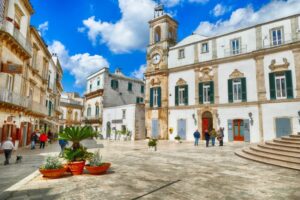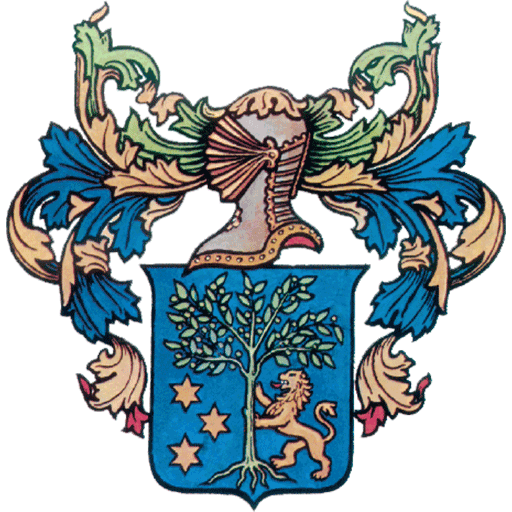Martina Franca
Index
Centro agricolo, commerciale e industriale noto per l’architettura barocca, sorge sulle propaggini meridionali delle Murge, al confine delle province di Taranto e Brindisi con la città metropolitana di Bari.
Where is Martina Franca located?
Comuni confinanti
Cisternino (BR) 8,9 km
Alberobello (BA) 12,3 km
Crispiano 14,1 km
Ceglie Messapica (BR) 16,7 km
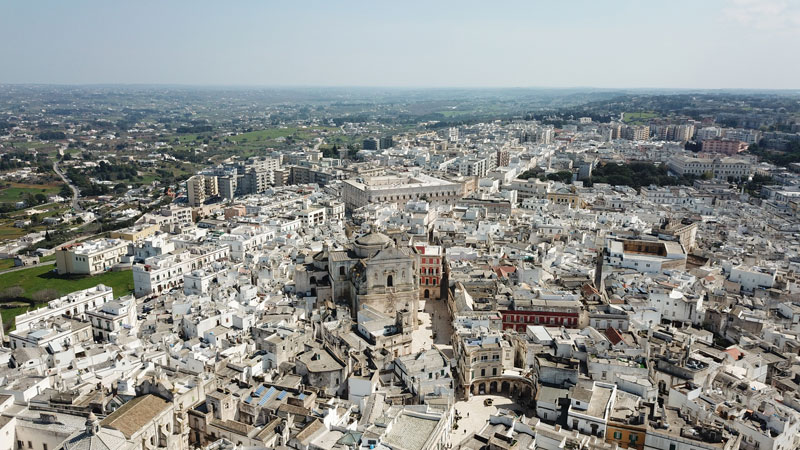
What to see in Martina Franca?
The name Martina, in the local dialect “Martène”, derives from the devotion of the citizens to San Martino di Tours. A first settlement of the city was in fact born on a mountain called San Martino. Understanding why this beautiful town is called “Martina”, one wonders about the “Franca”. This adjective was added in 1310 by Philip I of Anjou when I granted the city some privileges such as perpetual state property and some franchises.
Initially the city was called Franca Martina, over the years it lost its perpetual state property and was called again only Martina. After the unification of Italy, in 1861, the city took its current name: Martina Franca.
Where
We are located in the province of Taranto, in the town famous for the Valle d’Itria festival, nestled in the southern part of the Murgia.
The town is surrounded by olive trees, trulli and vineyards and is only 30 km from Taranto, the provincial capital. It will therefore be enough to go only a few kilometers from the city to find a magical and enchanted place, that is the historic center of the country.
History
Several findings on Monte Fellone make us understand that the area was inhabited since the Neolithic. In Monte Fellone then there are traces of horse farms dating back to the historical period of the Middle Neolithic. The breeding of horses, in that historical period, is quite rare for Southern Italy and is a unique find, at least until today, in Puglia.
In Specchia Tarantina it is possible to admire many specchie. These are structures that were used to control the territory. They were placed near the borders that divided Taranto and Messapi.
Like all neighboring towns, Martina Franca over the centuries has also suffered the influence of the Lombards and the Eastern Roman Empire.
If we want to talk about the village of Martina Franca we have to get to the 10th century, the year in which some Taranto people fleeing the continuous attacks by the Saracens fled to Monte di San Martino. A community of shepherds joined them. In the thirteenth century the territory became the property of the Swabians. Only in 1300, at the behest of Philip I of Anjou, did Martina Franca become a municipality.
What see
Old Town
Churches and historic buildings will certainly be very beautiful to see and admire, something much appreciated especially by those who love worship, art and history. But also a walk in the historic center of Martina Franca is not far behind.
Some streets are narrow, there are dead ends and some small hidden streets. At first glance it looks a lot like a labyrinth, a fascinating urban labyrinth. Today it might seem an unusual thing but in the past such a situation could be advantageous for the inhabitants who, in case of attack by the enemies, knowing well the roads of their country could easily sow them and buy time for an escape.
The streets of the historic center of Martina Franca are full of clubs and are an ideal place for walks, both in summer and in winter. The citizens of Taranto, as well as many tourists, often go to Martina Franca during the summer, to get some refreshment on the hottest evenings and get away from the heat of the city.
The historic center of the town is very characteristic and full of churches and historic buildings. Among the churches that we recommend to visit there is certainly the Basilica of San Martino which was built around the second half of the eighteenth century. The Basilica shows all the splendor of the Martinese baroque and inside it is possible to find the relics of Santa Comasia.
Among other religious monuments we recommend visiting the Church of San Domenico, the Church of the Beata Vergine del Carmelo, the Church of Sant’Antodio da Padova and the Church of Cristo Re which is one of the last built in the country.
Also in the village of Martina Franca we find several noble palaces. The most important is certainly the Palazzo Ducale and to follow, among others, we find Palazzo Nardelli, Palazzo Barnaba, Palazzo Carucci and Palazzo Torricella.
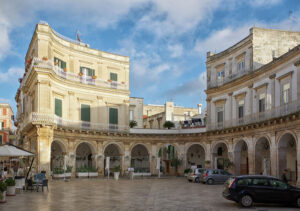
The Basilica of San Martino is located in Piazza Plebiscito. It was built in the eighteenth century on the same place where the Romanesque collegiate was first located. It has a majestic facade in typical Martinese baroque, in the central part of the same it is possible to admire the image of the Patron Saint.
Inside, art lovers will be able to see the main altar in polychrome marble dating back to 1773, the chapel of the Blessed Sacrament, some paintings by Domenico Antonio Carella and a nativity scene by Stefano da Putignano, Italian sculptures from the fifteenth and sixteenth centuries.
The Basilica of San Martino houses the relics of Santa Comasia and Santa Martina. Since 1988, at the behest of Pope John Paul II, it has become a Minor Basilica.
Church of the Carmine
The Chiesa del Carmine, whose full name is the Church of the Beata Vergine del Carmelo, was built starting in 1730. The works ended in 1758. It appears outside the city walls and displays a very elegant, typically Baroque architectural style. Inside there is an important polychrome statue dedicated to Santa Maria della Misericordia by Stefano da Putignano.
Church of Sant’Antonio da Padova
This church was initially dedicated to Santo Stefano. It was built in the 15th century by the Observant Franciscans. In 1835 the facade was rebuilt in a neoclassical style.
Inside the Church of St. Anthony of Padua there are two sculptures, one dedicated to St. Stephen and the other dedicated to St. Anthony. Both works are by Stefano da Putignano. In the cloister there are some eighteenth-century frescoes.
Church of San Vito
It is one of the oldest structures in the city. It is located in the historic center, between via Ignazio Ciaia and via Mazzini. The exact date of construction is not known, it is assumed that it was built between the end of the 13th century and the beginning of the 14th century.
The Church of San Vito is imposing, with an ashlar facade and a bell gable. Inside there is a single nave. During the 1700s the interiors of the Church of San Vito were redecorated in a Baroque style.
Ducal Palace
In Piazza Roma there is the Palazzo Ducale, a structure built during the second half of the seventeenth century and commissioned by Duke Petracone Caracciolo. The structure has typical elements of the Renaissance that meet the Lecce Baroque and the typical imprint of local architecture.
For years it was the residence of the Caracciolo dukes, today it is the seat of the Municipality of Martina Franca. Some of the rooms inside it are very popular, such as Arcadia, Myth and the Bible. The names of the rooms are due to the frescoes housed inside them, works dating back to 1776 by Domenico Carella, an artist from Francavilla Fontana.
Trulli
Martina Franca is located in the Itria Valley and has, especially in the countryside, several trulli like those that have made Alberobello famous all over the world. These are conical dry stone constructions typical of Alberobello and much of central-southern Puglia (see Valle d’Itria). These constructions were used as dwellings or as small warehouses for farmers in the countryside.
Although the trulli are originally from Alberobello, it is possible to admire many of them also in the Martinese area. The Itria Valley is characteristic of the trulli and dry stone walls that were used to delimit the land owner’s territory.
Monte Fellone cave
The municipality of Martina Franca now boasts about 50,000 inhabitants and has very ancient historical origins. In fact, one of the oldest settlements dates back to the Neolithic period and it is possible to admire some archaeological finds, made around the 60s, in the cave of Monte Fellone.
It is possible to rediscover a part of history thanks to what remains of a horse farm. It is also important to remember the presence of some specchie including the famous Specchia Tarantina which was going to divide and defend the borders between Messapi and Taranto.
Bosco delle Pianelle
The Bosco delle Pianelle today (precisely since 2002) is a Regional Nature Reserve. It is located along the Provincial Road 581 that connects Martina Franca to Massafra.
The Protected Natural Area includes 590 hectares of land. Inside there are mainly fragno trees, oaks of the downy type and holm oak trees. In terms of fauna, the area is inhabited by kestrels, sparrow hawks and various nocturnal birds of prey such as the owl, the tawny owl and the barn owl. There is no shortage of foxes, stone martens, wild boars and fallow deer.
During the twentieth century in the Bosco delle Pianelle many brigands found refuge.
Museums
There are two different museums in the country. The first is present in the Palazzo Ducale and is dedicated to the wood of the pianelle. Here it is possible to view a beautiful exhibition concerning the peasant civilization of other times as well as the beauty of the local fauna and flora. The second museum, that of Philip I of Angio, can be visited at the Palazzo Ducale. It is a museum that exhibits contemporary art inspired by the Martinese territory.
Visita il nostro Bed & Breakfast a Martina Franca dove alloggiare per poterla visitare.
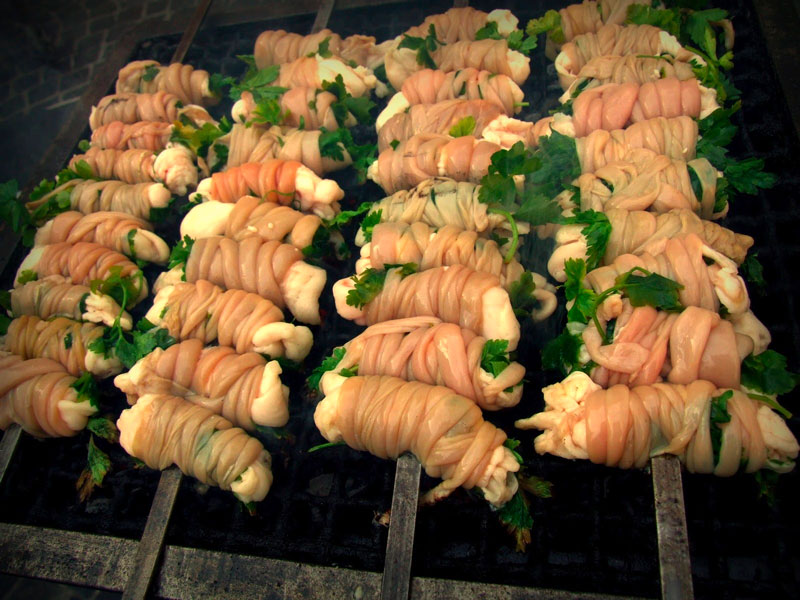
What to eat in Martina Franca? Where to eat in Martina Franca?
One of the excellent typical products of Martina Franca, so much so that it has won the slow food presidium, is undoubtedly the capocollo. It is a sausage obtained by processing the upper part of the neck and part of the shoulder of the pig: a specialty that you must taste, if you have never done it before, for its balance of flavor and aroma. The microclimate of the area itself, ventilated and dry, favors its processing, which exploits the bark of oaks and other plants for the smoking process of the capocollo. The breeding of pigs also contributes to making this sausage a delicious product, which are fed with the acorns of the surrounding woods: a mix that makes the capocollo a representative of the aromas and flavors that a land like Puglia can offer its visitors. . With a capocollo platter paired with slices of caciocavallo cheese, dried tomatoes and Altamura bread with a drizzle of intensely fruity extra virgin olive oil, you will certainly offer yourself an appetizer that will give you a mix of inimitable traditional flavors.
Vuoi assaggiare i piatti tipici della cucina di Martina Franca? prenota ora il tuo tavolo!
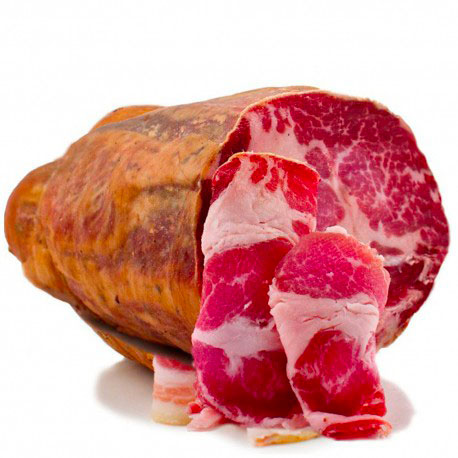
What to do in Martina Franca?
La vita notturna di Martina Franca non è paragonabile a quella delle vicine Monopoli ed Ostuni ma, in ogni caso, ospita locali notturni dove potersi divertire in compagnia di tanta gente e tanta musica.
In the main squares and in the characteristic streets you will certainly find a lounge bar or a pub where you can spend a quiet evening.
Scegli la tua dimora! per dormire vicino a Martina Franca in B&B con piscina.
The history of Martina Franca:
In the early Middle Ages the territory was under the influence of the Lombards who alternated with the authority of the Eastern Roman Empire and in the 10th century a place of defense against the invasion of the Saracens. The remains of some large dry stone walls called paretone could be referable to the presence of the Limitone of the Greeks to the southwest. In the 9th century a group of Jews fleeing from Oria, and among the few survivors of the large Jewish community of Oria, joined the settlement built around the hamlet of San Salvatore nella Lama del Fullonese.
The origins of Martina Franca, as a village, date back to the 10th century, when a small village of refugees from Taranto arose on Monte di San Martino, fled from the continuous devastation of the Saracens, and to which a community of shepherds was later added. In fact, in the 13th century the mountain falls under the ownership of Glicerio de Persona (Glicerio de Matino), feudal lord of Matino and Tuglie and lord of the Terre di Ceglie del Gualdo, Mottola, Soleto and Casale di San Pietro in Galatina
Glicerio sided with Manfredi of Sicily, son of Frederick II of Swabia and King of Sicily against the Angevins. Conrad IV of Swabia, the last of the Swabians, also fell, Glicerio took refuge in Gallipoli, leading the defense against the Angevin siege. When the city fell he was captured, taken to prison in the castle of Brindisi (together with his sons Gervasio, Giovanni and Perello) and finally suffered the gallows.
Around 1300 Martina Franca was elected municipality by order of the Principality of Philip I of Anjou. Philip I granted Martina to Pietro del Tocco to reward him for the services he performed.
Il territorio all’epoca consisteva in un castello situato storicamente nell’attuale zona denominata “Montedoro”, e da due miglia di terreno intorno al castello, sottratto dal territorio di Taranto, dall’Università di Monopoli e dall’Università di Ostuni per l’insediamento rurale di massari (in martinese u massèr è un contadino affittuario di terreni e masserizie). Sembra che Filippo d’Angiò avesse concesso anche dei diritti e delle franchigie a chi fosse venuto ad insediarsi a Martina, e per questo fu denominata “Franca”.
Where to sleep in Martina Franca?
Visita il nostro B&B a Martina Franca dove alloggiare per poterla visitare.
Why visit Martina Franca?
Martina Franca, Comune di quasi 50mila abitanti, sorge sulle colline sud-orientali della Murgia che affacciano sulla Valle d’Itria. Nota per l’architettura barocca e per il Festival della Valle d’Itria, la città è una delle mete turistiche della Puglia da non perdere. Offre diverse attrazioni, tra monumenti, edifici storici e paesaggi mozzafiato. Oltre ai vostri occhi potrete deliziare il palato degustando i vari prodotti tipici (orecchiette, grigliate di carne con bombette e gnummareddi, prodotti caseari come burrata e stracciatella, vini dei vigneti locali, dolci e tanto altro).
Do you want to visit Martina Franca and save on the price of the B&B? Check our availability and ask for a discount!
RELATED ARTICLES
Agriturismo Masseria Alberotanza B&B e Ristorante a Conversano
Secondary phone: +393317271337
Email: info@masseriaalberotanza.it

